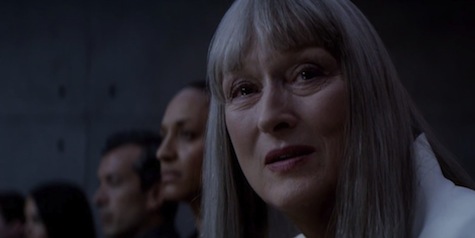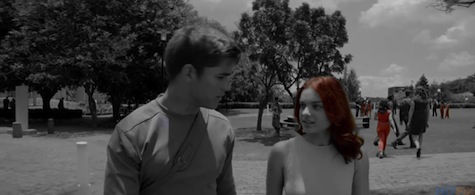I liked the movie adaptation of Lois Lowry’s The Giver, but I didn’t love it. (Precision of language!) I was curious to see the depictions of the utopian Community, built on the safe and conflict-free notion of “sameness.” Jeff Bridges embodied the character of the Giver in a way familiar and comforting to those who grew up reading the book. Watching Jonas discover colors for the first time is a strangely emotional experience. But ultimately, the movie did not stir in me the same depth of feeling as reading that classic for the first time.
Now, let’s drop the Community syntax and actually talk about what did and didn’t work in this adaptation of the young adult classic.
For myself and so many twentysomething Millennials, The Giver was baby’s first dystopia. I still remember closing it—after wrinkling my nose at the ambiguous ending—and thinking in wonderment, There are more books like this? It’s an entire genre? Once we discovered more complex dystopian novels, The Giver was relegated to a nostalgic spot on our bookshelves, physical or mental; we never forgot that first thrill of surprise at the twist, but we also likely didn’t reread it.
I’m willing to bet, though, that we’ll make up the majority of the movie’s audience. And that nostalgia factor that will propel us to see the black-and-white Community, its injections against Stirrings, and the terror of “release to Elsewhere” rendered real, might turn away those who didn’t read the book within a specific chunk of their adolescences.

As adaptations go, it’s very decent. The Community is rendered in chilling detail, from the disturbing symmetry of the buildings to the stiff but caring family units to the structured rituals that help Jonas (Brenton Thwaites) and his peers grow into their respective roles within an arguably very functional society. Of course, that’s before Jonas becomes the Community’s first Receiver of Memory in over ten years, and starts discovering truths and feelings the Community has protected its members from, to their own detriment.
More than just an accurate adaptation, this is also a story about fathers and sons. Bridges had long planned to cast his father Lloyd as the Giver, but decades after his father’s death and after the movie rights finally got disentangled, Bridges realized that he was the perfect age to play the part.
And he’s splendid at it. Intensely in-your-face during the memory-transfer scenes, and rather awkward in-between them, but gruffly affectionate and proud, too. He seems to hold every word around in his mouth, turning it over multiple times before finally uttering it, so that you know he really thought through what he’s sharing. He plays the Giver’s weariness well, carrying the burden of so many awful memories while the Community prospers, albeit in an anesthetized state.
If you want to play a fun little game, you can guess at the motivations behind which clips the producers decided to show as Jonas’ memories. There’s care taken to show mostly generic memories, both positive and negative: sledding in the snow, a medieval (or Renaissance Faire?) wedding, poaching an elephant. When they do ground us in time, it’s carefully chosen: a war scene that’s almost certainly Vietnam, a shot of Nelson Mandela, and a concert set in 2025—but no 9/11. It raises a larger question about how much movie adaptations should incorporate current events into dystopian futures.
You do get the sense that certain roles were expanded for the actors who played them, like Taylor Swift as the Giver’s previous pupil Rosemary, and Katie Holmes as Jonas’ mother and the Director of Justice, who nonetheless answers to Meryl Streep’s Chief Elder (a role that I guarantee got very little book space devoted to it). Streep is blandly threatening; you’ll likely want to know why the Chief Elders, who are supposed to rely on the Receiver of Memory for counsel, seem to already know all the dark secrets they’re protecting the Community against. But it’s never elaborated upon.

One element that gets successfully fleshed out is the push-and-pull among Jonas, his best friend Asher (Cameron Monaghan), and his best friend (but also love interest) Fiona (Odeya Rush, also appearing in Goosebumps). Once Jonas gets carte blanche to stop taking his injections and lie to the Community, he chooses Nurturing Center attendee Fiona as his unwitting partner in crime to practice all of his newfound knowledge on. Though she’s at first hesitant and scared, she’s also thrilled by the new feelings and glimpses of color.
But while those two are playing Adam and Eve, drone pilot Asher is playing the angel guarding the Garden of Eden. It’s never clear if his jealousy springs from some repressed Stirrings for Fiona himself, or if he’s truly irritated by their flouting of the rules. At any rate, it makes him the third wheel—something on which the Elders pounce later, when they’re tracking the Jonas after he goes rogue. For a utopian community based on sameness and no pesky feelings, they sure do tap into the ol’ feels when it’s convenient for them.

While The Giver follows much of the same plot of the book, with Jonas making a radical change to free the Community, the film exercises the omniscient third person POV that doesn’t exist in the novel, and shows us what happens to everyone else after his actions. The ending errs a little more on the side of literal than ambiguous, with the capacity, but not necessity, for a sequel.
The Giver is all rather on-the-nose, with everything spelled out for you. There’s literally a part where the closest thing to a MacGuffin is introduced, but even as we’ve already guessed at its purpose, Jonas double-checks with the Giver that that’s what it actually does. As a dystopian story for adults, it won’t say anything new. But for those whose reading of the novel was tantamount to watching our world bloom into color from black-and-white, it retains the emotional punch of Lowry’s book.
Photos: The Weinstein Company
Natalie Zutter is the editor of all things geek over at Bookish. She is a playwright, foodie, and the co-creator of Leftovers, a webcomic about food trucks in the zombie apocalypse. Her writing has also appeared on Ology and Crushable. You can find her commenting on pop culture on Twitter.










